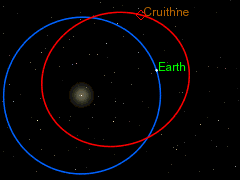準衛星

準衛星是與行星有著1:1軌道共振,在公轉許多次後便會接近行星並留駐的天體。準衛星繞太陽公轉的軌道週期與行星相同,但是有著不同的離心率(通常更大),如右圖所示。當從行星上觀察這顆行星的準衛星時,會出現繞著行星的橢圓行逆行軌跡。對比於真衛星,準衛星的軌道位於行星的希爾球之外,並且是不穩定的。經過一段時間的發展,傾向於成為其他類型的共振運動,使它們不再逗留在行星的附近,然後可能又會回到準衛星的軌道,等等不一而足。其他型式的1:1共振軌道包括馬蹄形軌道和環繞著拉格朗日點的蝌蚪形軌道,但是這種軌道的天體在繞行太陽公轉多次之後,不會停留在接近行星的經度上。已知馬蹄形軌道的天體有時會轉移到一個相對較短的準衛星軌道[1],因此有時會混為一談。這種例子像是2002 AA29。
例子
[編輯]
- 地球
至2023年,已知地球有7顆準衛星:(3753)克魯特尼、2002 AA29、2003 YN107、2004 GU9[2]、2010 SO16[3]、2016 HO3[4]和2023 FW13。這些天體會在準衛星軌道上逗留數十年、數百年或更長的時間[1]。
- 金星
金星有一顆準衛星,2002 VE68。這顆小行星也是水星軌道穿越小行星和越地小行星;它成為金星的伴侶似乎至少已經有7,000年了,並且註定在大約500年後將從現有的軌道中被彈出[5]。
- 其他的行星
基於類比相信天王星和海王星在太陽系(大約45億年)有能力掌握住準衛星[6],但是靠近木星的準衛星軌道只能維持穩定約10,000,000年,土星只能維持100,000年。目前還不能確定這些行星是否有準衛星。
- 人造衛星
在1989年初,前蘇聯的弗伯斯2號太空船進入環繞火衛一的準衛星軌道,與火衛一的平均軌道半徑距離大約只有100公里[7]。依據計算,這艘太空船可以在軌道上逗留數個月之久。但因為導引系統故障,這艘太空船失蹤了。
相關條目
[編輯]參考資料
[編輯]- ^ 1.0 1.1 Connors, M.; Chodas, P.; Mikkola, S.; Wiegert, P.; Veillet, C.; Innanen, K. Discovery of an asteroid and quasi-satellite in an Earth-like horseshoe orbit. Meteoritics and Planetary Science. 2002-10-01, 37 [2022-11-04]. Bibcode:2002M&PS...37.1435C. ISSN 1086-9379. doi:10.1111/j.1945-5100.2002.tb01039.x. (原始內容存檔於2022-07-28).
- ^ Brasser, R; Innanen, K. A; Connors, M; Veillet, C; Wiegert, P; Mikkola, Seppo; Chodas, P. W. Transient co-orbital asteroids. Icarus. 2004-09-01, 171 (1) [2022-11-04]. Bibcode:2004Icar..171..102B. ISSN 0019-1035. doi:10.1016/j.icarus.2004.04.019. (原始內容存檔於2015-11-06) (英語).
- ^ Braconnier, Deborah. New horseshoe orbit Earth-companion asteroid discovered. Phys.org. [2022-11-04]. (原始內容存檔於2022-05-25) (英語).
- ^ Greicius, Tony. Small Asteroid Is Earth's Constant Companion. NASA. 2016-06-15 [2016-06-23]. (原始內容存檔於2016-06-19).
- ^ Mikkola, S.; Brasser, R.; Wiegert, P.; Innanen, K. Asteroid 2002 VE68, a quasi-satellite of Venus. Monthly Notices of the Royal Astronomical Society. 2004-07, 351 (3) [2022-11-04]. Bibcode:2004MNRAS.351L..63M. ISSN 0035-8711. doi:10.1111/j.1365-2966.2004.07994.x. (原始內容存檔於2021-12-20) (英語).
- ^ Wiegert, Paul; Innanen, Kimmo; Mikkola, Seppo. The Stability of Quasi Satellites in the Outer Solar System. The Astronomical Journal. 2000-04-01, 119 [2022-11-04]. Bibcode:2000AJ....119.1978W. ISSN 0004-6256. doi:10.1086/301291. (原始內容存檔於2022-05-01).
- ^ The orbit is erroneously called "quasi-synchronous". [2011-08-17]. (原始內容存檔於2009-07-20).
外部連結
[編輯]- Quasi-satellite Information Page (頁面存檔備份,存於網際網路檔案館)
- Earth's New Travelling Companion: Quasi-Satellite Discovered (頁面存檔備份,存於網際網路檔案館)
- Astronomy.com: A new "moon" for Earth (頁面存檔備份,存於網際網路檔案館)
- Discovery of the first quasi-satellite of Venus (頁面存檔備份,存於網際網路檔案館) – University of Turku news release(August 17, 2004)。
